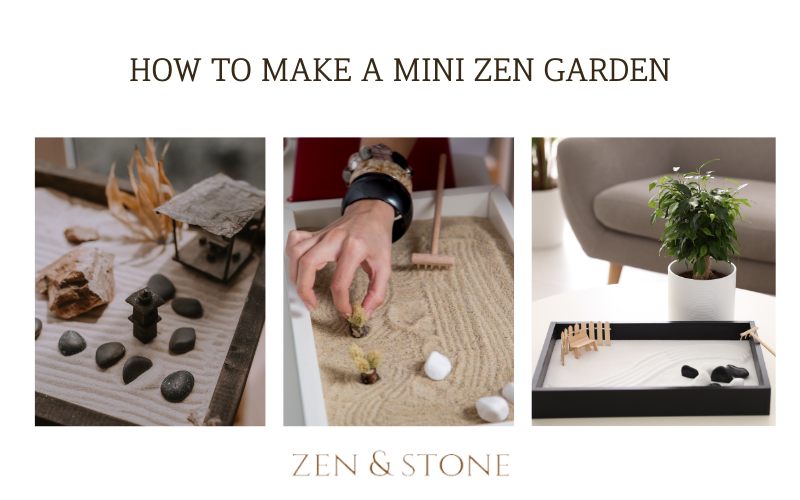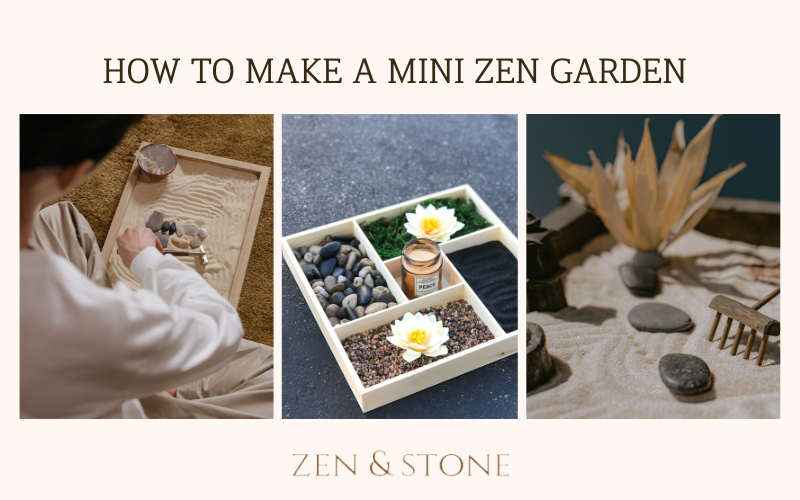
29 Nov How to Make a Mini Zen Garden
If you are looking for a place of tranquility, mental clarity, and beauty a Zen garden may be the perfect thing. Zen Gardens were originally maintained by Zen Buddhist monks and were full-size outdoor spaces designed to aid monks in the daily ritual of meditation and focus.
Zen Buddhist monks spent time raking the sands and rocks of their Zen gardens into special, often intricate, patterns. They learned to pay attention to detail as they worked to maintain the Zen garden day in and day out.
Oftentimes the monks would meditate in their garden and use it as a place of relaxation and restoration. Today Zen gardens serve much the same purpose for people around the world.
What are Mini Zen Gardens?
Many people want to experience the beauty and serenity of a Zen garden in their daily life but do not have the space for a full-sized outdoor garden. That is why the mini Zen garden has become a popular option for creating a small tranquil space for zen-scaping.
Mini Zen garden ideas usually vary and are designed to rest on tabletops, desks, or counters in our homes and offices. They provide the opportunity for breaks from stress and the hustle of daily life.
Being able to rake the rocks in a stone garden or sand of a Zen garden is a relaxing and soothing practice that calms the mind and resets our thoughts. Zen gardens such a desktop zen garden provide an opportunity for active meditation and reflection.
For those who would like a DIY mini zen garden of their own, we have put together the perfect starter guide for making your own Zen garden in a few simple steps. With one afternoon, a few supplies, and our helpful tips you will be enjoying your own DIY Zen garden today.
Choosing a Zen Garden Style
Traditionally a mini zen garden was made using sand as the main garden element. Sand is easy to maintain, able to be raked and patterned, and can be found in a wide variety of places. You do not have to use traditionally colored sand, in fact, many Zen gardens don’t!
Zen garden sand can be black, white, brown, or any other color you find soothing. Typically people avoid bright and distracting colors that might have the opposite effect of bringing tranquility to a space.
Zen gardens are typically dry spaces, meaning they aren’t made with living plants that need watering. However, if adding small plant features to your garden sounds enjoyable to you, that is certainly an option.
What are Zen Gardens Usually Decorated With?
On top of fine sand, zen gardens are often decorated with decorative stones in varying sizes. These can be placed and moved around the garden as part of intentional raking and patterning.
Many people will add an important crystal to their garden that helps them feel calm and centered.
Some zen gardens also use air plants to add a bit of greenery and a natural feel to an indoor miniature zen garden.
Your own mini zen garden should be styled in a way that feels relaxing and nurturing to you.
Supplies for Making a Zen Garden
To make your own DIY mini Zen garden you will want the following basic supplies:
Container
The container you choose for your Zen garden is based on your own unique taste.
Oftentimes people choose a container that is made of natural elements such as wood or decorative stone. Others prefer glass containers or sleek black containers to give their garden a modern, elegant feeling.
The size of your container will be determined by where you want to put your Zen garden. For your first garden use any container you enjoy that fits nicely into your display space.
Sand
As we discussed early, the color of your sand is an individual decision. For a typical Zen garden, we want to stick with sand patterns that have calming and neutral colors. Also, sand that is fine and soft is often more appealing for raking than heavy ground coarse sand.
Sand can be found at most local craft stores.
Stones
Some people prefer a stone garden more than a sand-based garden. Even if your garden features a large swath of black sand, a few stones in the garden add variety and appeal.
Stones can be a naturally rough-faced stone for a more natural feel, or a smooth polished stone that catches the eye of those passing by. A lot of people enjoy putting in an important crystal that boosts their energy or helps them feel centered.
Look for stones at craft stores or even outside near your home.
Mini Rake
Your main interaction with your Zen garden will be through raking designs and patterns into the sand. You will want a mini rake that feels comfortable in your hand.
There are mini rakes designed and sold for Zen gardens. Other people use mini forks or other toothed utensils as rakes for their gardens.
Air Plants (optional)
An air plant adds a natural and living appearance to your garden. They add interest and draw the eye while not requiring regular watering and specialized care. A wide variety of air plants are available for purchase at home stores and garden stores.
Essential Oils (optional)
Some people enjoy the aromatherapy of adding a few drops of essential oil to their Zen garden sand to be stirred and refreshed when raking.

4 Steps To Make Your Own Zen Garden
Ready to make your own Zen garden? Follow these easy steps to get started!
1. Choose Your Container and Fill it With Sand
Spend some time selecting a container you love looking at and then fill the container with your chosen sand. As you fill the container be sure to gently sift it from side to side to help the sand lay flat and smooth.
If you are adding oils or other aromas to your sand, this is a great time to add them in. Remember with most aromas and oils a little bit goes a long way.
2. Add Decorative Stones or Crystals To Your Garden
You should have selected a few stones for your garden when you were gathering your supplies. Make sure to choose stones whose appearance you enjoy.
If you have chosen to use crystals in your garden, spend some time reflecting on the properties of those crystals and your intention behind displaying them in your Zen space. Your garden can double as both a Zen and meditation garden for you during your day.
The placement of your stones can change over time, but choosing a placement that keeps in mind any patterns you may want to rake into your garden is wise. Your stones can be a compliment to your pattern or even a built-in part of your overall design.
3. Add Any Air Plants You Have Selected
Traditional Zen Buddhist monks did not include plants as part of their gardens, but when making a mini Zen garden adding in plants can help build a sense of natural space.
Select plants that complement, but don’t overwhelm your garden and that don’t require much water for survival. Your container is filled with sand and will not have drainage for excess water if you attempt to care for traditional plants.
If you prefer not to have plants in your garden, that is perfectly fine! Remember, this garden is uniquely yours and should reflect you and your preferences before anyone else’s.
4. Create Your First Sand Pattern With Your Mini Rake!
Now for the fun (and truly calming) part of preparing your Zen garden. Raking in your first design!
You can rake any pattern you choose into your Zen garden and rake it as many times as you want. Many people find that raking the same pattern repeatedly for several minutes helps to focus and calm a busy mind.
If you are using your garden to aid in meditation it is helpful to choose a pattern that flows well and can be repeated without the need to frequently lift and reposition your rake.
Spend Time Enjoying Your Very Own Zen Garden
Now that you have used a few simple supplies and a little time, you can enjoy your Zen garden for years to come. Try spending a few minutes each day raking your garden and letting it become a bright spot of reflection in a busy world.
If you become tired of your Zen garden’s appearance it is easy to change and modify it to fit your changing preferences. You can change out the rocks and plants for new ones, or even empty your garden and start with fresh sand.
If you tire of your garden’s container, simply choose a new one and transition your garden over. You may find that you want to have more than one Zen garden for different rooms in your home. Having one Zen garden at work and another at home is also a common practice.
Sharing your Zen garden with others can also bring large amounts of joy to people who have carefully made a garden they are proud of.
We hope that you have found making your own mini zen garden to be a relaxing and enjoyable activity that has long-lasting rewards.

Sorry, the comment form is closed at this time.